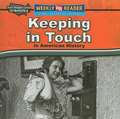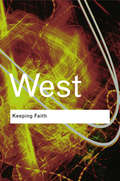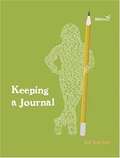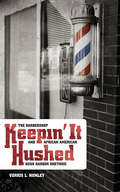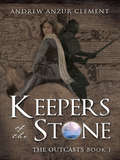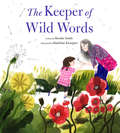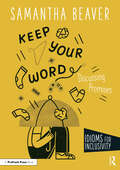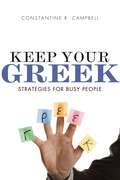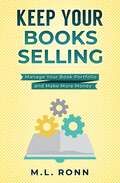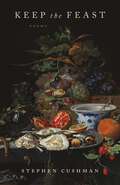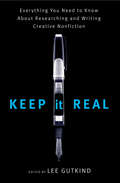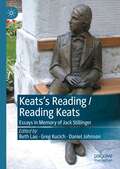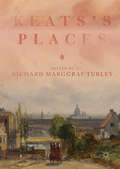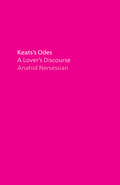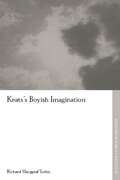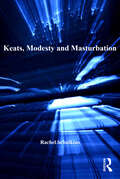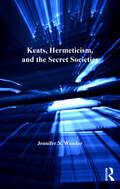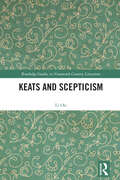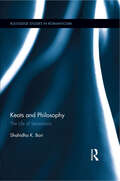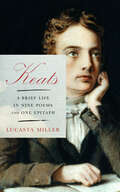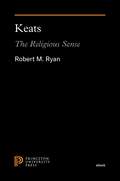- Table View
- List View
Keeping in Touch in American History (How People Lived In America)
by Dana RauThis book traces the history of delivering news and messages over the years.
Keeping in Touch
by Ellen GoodmanIn these columns of the past four years, Goodman writes about people, issues and popular inanities with a skill that makes her a master of the 750-word form.She brings us from Liz Taylor's need for "privacy," to aerial burials, to the Nancy Drew books, to thoughtful examinations of AIDS and other controversial topics of concern.
Keeping Faith: Philosophy and Race in America (Routledge Classics)
by Cornel West'The sheer range of West's interests and insights is staggering and exemplary: he appears equally comfortable talking about literature, ethics, art, jurisprudence, religion, and popular-cultural forms.' - Artforum Keeping Faith is a rich, moving and deeply personal collection of essays from one of the leading African American intellectuals of our age. Drawing upon the traditions of Western philosophy and modernity, Cornel West critiques structures of power and oppression as they operate within American society and provides a way of thinking about human dignity and difference afresh. Impressive in its scope, West confidently and deftly explores the politics and philosophy of America, the role of the black intellectual, legal theory and the future of liberal thought, and the fate of African Americans. A celebration of the extraordinary lives of ordinary Americans, Keeping Faith is a petition to hope and a call to faith in the redemptive power of the human spirit.
Keeping a Journal
by Trudi TrueitAdventure, mystery, and suspense are the elements of any good book - even your very own journal. Journal writing holds the key to your imagination. What do you secretly wish for? What have you always wanted to try? Some journals are filled with questions and poems while others are overflowing with sketches and collages. Still others have been passed down through history, opening doors to events of the past. Keeping a Journal will guide beginners through the creative process; it also offers new ideas for experienced journal writers. Writing exercises and prompts for creating a 30-day journal are included.
Keepin' It Hushed: The Barbershop and African American Hush Harbor Rhetoric
by Vorris L. NunleyExamines the barbershop as a rhetorical site in African American culture across genres, including fiction, film, poetry, and theater.
Keepers of the Stone: The Outcasts
by Andrew Anzur ClementIn a far corner of the British Empire, a mysterious girl gallops away on a horse, fleeing for her life. Malka has sacrificed everything to protect an all-powerful stone from falling into the hands of the malevolent Urumi. Raised by a Sect of thieves, the girl is a trained killer. But will her lethal skills be enough to defeat the Shadow Warriors and their superhuman abilities? The fate of the stone may depend on Stas, a courageous boy from a country that is not on any map. Nell, his friend since childhood, has been caught up in the Dark Order’s evil designs. The young outcasts must confront demons, real and imagined, with the help of mystical new allies. Their journey will take them to distant lands and change their lives forever.
Keepers of the Code
by Robert LeckerKeepers of the Code explores the complex network of associations and negotiations that influenced the development of literary anthologies in English Canada from 1837 to the present. Lecker shows that these anthologies are deeply conflicted narratives that embody the tensions and anxieties felt by their editors when faced with the challenge of constructing or rejecting national ideals. He argues that these are intensely self-conscious works with their own literary mechanisms and architecture. In reading the history of these anthologies, he witnesses a complex narrative of nation, a compelling story about the values and interests informing English-Canadian literary history.
The Keeper of Wild Words: (nature For Kids, Exploring Nature With Children)
by Brooke SmithA touching tale of a grandmother and her granddaughter exploring and cherishing the natural world.Words, the woods, and the world illuminate this quest to save the most important pieces of our language—by saving the very things they stand for.When Mimi finds out her favorite words—simple words, like apricot, blackberry, buttercup—are disappearing from the English language, she elects her granddaughter Brook as their Keeper. And did you know? The only way to save words is to know them.• With its focus on the power of language and social change, The Keeper of Wild Words is ideal for educators and librarians as well as young readers.• For any child who longs to get outside and learn more about nature and the environment• A loving portrait of the special relationship that grandparents have with their grandchildrenFor children who love such books as Outside Your Window: A First Book of Nature, And Then It's Spring, and Finding Wild.Brooke Smith is a poet and children's book author. She lives in Bend, Oregon, at the end of a long cinder lane. Brooke writes daily from her studio, looking at the meadow and many of the wild words she cherishes.Madeline Kloepper is a Canadian artist with a Bachelor of Fine Arts and Major in Illustration from Emily Carr University of Art and Design. Her work is influenced by childhood, nostalgia, and the relationships we forge with nature. She lives in Prince George, British Columbia.
Keep Your Word: Discussing Promises (Idioms for Inclusivity)
by Samantha BeaverTo get the complete Idioms for Inclusivity experience, this book can be purchased alongside four others as a set, Idioms for Inclusivity: Fostering Belonging with Language, 978-1-032-28635-8. Informed by sociolinguistic research, yet written accessibly, Keep Your Word challenges readers to investigate the act of promising as it relates to both language-use and inclusivity. This engaging and delightfully illustrated book invites students to engage with concepts such as: the cultural meaning of the idiom "keep your word", Speech Acts and Felicity Conditions, two frameworks that linguists use to research and understand promises, why the expectation to "keep your word" can make someone feel excluded, and how understanding the way language works can help learn to be more inclusive. Featuring practical inclusivity tips related to promises, this enriching curriculum supplement can be used in a Language Arts setting to learn about figurative language; in a Social Studies setting to discuss diversity, equity, inclusion, and belonging; or as an introduction to linguistics for students ages 7-14.
Keep Your Greek: Strategies for Busy People
by Constantine R. CampbellSeminarians spend countless hours mastering biblical languages and learning how the knowledge of them illuminates the reading, understanding, and application of Scripture. But while excellent language acquisition resources abound, few really teach students how to maintain their use of Greek for the long term. Consequently, pastors and other former Greek students find that under the pressures of work, ministry, preaching, and life, their hard-earned Greek skills begins to disappear. Con Campbell has been counseling one-time Greek students for years, teaching them how to keep their language facility for the benefit of those to whom they minister and teach. He shows how following the right principles makes it possible for many to retain—and in some cases regain—their Greek language skills. Pastors will find Keep Your Greek an encouraging and practical guide to strengthening their Greek abilities so that they can make linguistic insights a regular part of their study and teaching. Current students will learn how to build skills that will serve them well once they complete their formal language instruction.
Keep Your Books Selling: Manage Your Book Portfolio and Make More Money (Author Level Up #16)
by M.L. RonnWhen was the last time you updated one of your books? It's probably been a while, hasn't it? When we become authors, we publish our books and move on to the next story. Then YEARS pass by and we realize there were so many things we missed! Forgetting to update a book can cost you money. Here are some examples of horror stories that might be lurking in your book portfolio: Doing a promo and forgetting to change the price back… Publishing a wrong version of a book… Forgetting which book description you were supposed to use… Losing your book files because of a virus or damage to your computer… If your blood pressure is up, don’t worry—we all make these mistakes from to time. But if you want to become a prolific author AND make a good income, you must learn to manage your books properly. In this guide, prolific author M.L. Ronn will teach you the system he adopted to manage his growing portfolio of 70+ books of fiction and nonfiction. You'll discover: How to future-proof your books to keep them selling How to always know what's going on with all your books on all retailers Tools to help you stay on top of managing your books How to anticipate changes at book retailers that could make your book files obsolete How to prepare your heirs to manage your books when you die This book will help you get more organized and make more money from your books. If anything, it’ll stop you from losing money that you didn’t know you were losing. V1.0
Keep the Feast: Poems
by Stephen CushmanStephen Cushman’s Keep the Feast sings in the tradition of the psalmists and devotional poets, offering an intimate, ecstatic doxology, both exultant and indicting, spiritual and secular. His poems make prodigious and intrepid forays into the realms of history, sexuality, religious ardor, the imperiled planet, and the reasons for making art. At the heart of this three-part book lies the title poem, which takes as a formal model Psalm 119, the longest psalm in the Bible. In luminous verse, Cushman’s speaker rejoices in the commitments of faith, finding in them a way of living with the paradoxes of twenty-first-century life and of holding belief in an often-unfathomable world.
Keep It Real: Everything You Need to Know About Researching and Writing Creative Nonfiction
by Lee GutkindThe one guide every creative nonfiction writer needs to turn to when being "creative." Writers of memoir and narrative nonfiction are experiencing difficult days with the discovery that some well-known works in the genre contain exaggerations--or are partially fabricated. But what are the parameters of creative nonfiction? Keep It Real begins by defining creative nonfiction. Then it explores the flexibility of the form--the liberties and the boundaries that allow writers to be as truthful, factual, and artful as possible. A succinct but rich compendium of ideas, terms, and techniques, Keep It Real clarifies the ins and outs of writing creative nonfiction. Starting with acknowledgment of sources, running through fact-checking, metaphor, and navel gazing, and responsibilities to their subjects, this book provides all the information you need to write with verve while remaining true to your story.
Keats’s Reading / Reading Keats: Essays in Memory of Jack Stillinger
by Daniel Johnson Beth Lau Greg KucichThis book explores John Keats’s reading practices and intertextual dialogues with other writers. It also examines later writers’ engagements with Keats’s poetry. Finally, the book honors the distinguished Keats scholar Jack Stillinger and includes an essay surveying his career as well as a bibliography of his major publications. The first section of the volume, “Theorizing Keats’s Reading,” contains four essays that identify major patterns in the poet’s reading habits and responses to other works. The next section, “Keats’s Reading,” consists of six essays that examine Keats’s work in relation to specific earlier authors and texts. The four essays in the third section, “Reading Keats,” consider how Keats’s poetry influenced the work of later writers and became embedded in British and American literary traditions. The final section of the book, “Contemporary Poetic Responses,” features three scholar-poets who, in poetry and/or prose commentary, discuss and exemplify Keats’s impact on their work.
Keats's Places
by Richard Marggraf TurleyAs the essays in this volume reveal, Keats’s places could be comforting, familiar, grounding sites, but they were also shifting, uncanny, paradoxical spaces where the geographical comes into tension with the familial, the touristic with the medical, the metropolitan with the archipelagic. Collectively, the chapters in Keats’s Places range from the claustrophobic stands of Guy’s Hospital operating theatre to the boneshaking interior of the Southampton mail coach; from Highland crags to Hampstead Heath; from crowded city interiors to leafy suburban lanes. Offering new insights into the complex registrations of place and the poetic imagination, the contributors to this book explore how the significant places in John Keats’s life helped to shape an authorial identity.
Keats's Odes: A Lover's Discourse
by Anahid Nersessian“When I say this book is a love story, I mean it is about things that cannot be gotten over—like this world, and some of the people in it.” In 1819, the poet John Keats wrote six poems that would become known as the Great Odes. Some of them—“Ode to a Nightingale,” “To Autumn”—are among the most celebrated poems in the English language. Anahid Nersessian here collects and elucidates each of the odes and offers a meditative, personal essay in response to each, revealing why these poems still have so much to say to us, especially in a time of ongoing political crisis. Her Keats is an unflinching antagonist of modern life—of capitalism, of the British Empire, of the destruction of the planet—as well as a passionate idealist for whom every poem is a love poem. The book emerges from Nersessian’s lifelong attachment to Keats’s poetry; but more, it “is a love story: between me and Keats, and not just Keats.” Drawing on experiences from her own life, Nersessian celebrates Keats even as she grieves him and counts her own losses—and Nersessian, like Keats, has a passionate awareness of the reality of human suffering, but also a willingness to explore the possibility that the world, at least, could still be saved. Intimate and speculative, this brilliant mix of the poetic and the personal will find its home among the numerous fans of Keats’s enduring work.
Keats's Odes: A Lover's Discourse
by Anahid Nersessian“When I say this book is a love story, I mean it is about things that cannot be gotten over—like this world, and some of the people in it.” In 1819, the poet John Keats wrote six poems that would become known as the Great Odes. Some of them—“Ode to a Nightingale,” “To Autumn”—are among the most celebrated poems in the English language. Anahid Nersessian here collects and elucidates each of the odes and offers a meditative, personal essay in response to each, revealing why these poems still have so much to say to us, especially in a time of ongoing political crisis. Her Keats is an unflinching antagonist of modern life—of capitalism, of the British Empire, of the destruction of the planet—as well as a passionate idealist for whom every poem is a love poem. The book emerges from Nersessian’s lifelong attachment to Keats’s poetry; but more, it “is a love story: between me and Keats, and not just Keats.” Drawing on experiences from her own life, Nersessian celebrates Keats even as she grieves him and counts her own losses—and Nersessian, like Keats, has a passionate awareness of the reality of human suffering, but also a willingness to explore the possibility that the world, at least, could still be saved. Intimate and speculative, this brilliant mix of the poetic and the personal will find its home among the numerous fans of Keats’s enduring work.
Keats's Boyish Imagination (Routledge Studies in Romanticism #Vol. 1)
by Richard Marggraf TurleyFor many readers, John Keats's achievement is to have attainted a supreme poetic maturity at so young an age. Canonical poems of resignation and acceptance such as 'To Autumn' are traditionally seen as examples par excellence of this maturity. In this highly innovative study, however, Marggraf Turley examines how, for Keats, an insistence on 'boyishness' in the midst of apparent mature imagery is the very essence of his political contestation of the literary establishment.
Keats, Modesty and Masturbation
by Rachel SchulkinsExamining John Keats’s reworking of the romance genre, Rachel Schulkins argues that he is responding to and critiquing the ideals of feminine modesty and asexual femininity advocated in the early nineteenth century. Through close readings of Isabella; or the Pot of Basil, The Eve of St. Agnes, Lamia and ’La Belle Dame sans Merci,’ Schulkins offers a re-evaluation of Keats and his poetry designed to demonstrate that Keats’s sexual imagery counters conservative morality by encoding taboo desires and the pleasures of masturbation. In so doing, Keats presents a version of female sexuality that undermines the conventional notion of the asexual female. Schulkins engages with feminist criticism that largely views Keats as a misogynist poet who is threatened by the female’s overwhelming sexual and creative presence. Such criticism, Schulkins shows, tends towards a problematic identification between poet and protagonist, with the text seen as a direct rendering of authorial ideology. Such an interpretation neither distinguishes between author, protagonist, text, social norms and cultural history nor recognises the socio-sexual and political undertones embedded in Keats’s rendering of the female. Ultimately, Schulkins’s book reveals how Keats’s sexual politics and his refutation of the asexual female model fed the design, plot and vocabulary of his romances.
Keats, Hermeticism, and the Secret Societies (The\nineteenth Century Ser.)
by Jennifer N. WunderJennifer Wunder makes a strong case for the importance of hermeticism and the secret societies to an understanding of John Keats's poetry and his speculations about religious and philosophical questions. Although secret societies exercised enormous cultural influence during the late eighteenth and early nineteenth centuries, they have received little attention from Romantic scholars. And yet, information about the societies permeated all aspects of Romantic culture. Groups such as the Rosicrucians and the Freemasons fascinated the reading public, and the market was flooded with articles, pamphlets, and books that discussed the societies's goals and hermetic philosophies, debated their influence, and drew on their mythologies for literary inspiration. Wunder recovers the common knowledge about the societies and offers readers a first look at the role they played in the writings of Romantic authors in general and Keats in particular. She argues that Keats was aware of the information available about the secret societies and employed hermetic terminology and imagery associated with these groups throughout his career. As she traces the influence of these secret societies on Keats's poetry and letters, she offers readers a new perspective not only on Keats's writings but also on scholarship treating his religious and philosophical beliefs. While scholars have tended either to consider Keats's aesthetic and religious speculations on their own terms or to adopt a more historical approach that rejects an emphasis on the spiritual for a materialist interpretation, Wunder offers us a middle way. Restoring Keats to a milieu characterized by simultaneously worldly and mythological propensities, she helps to explain if not fully reconcile the insights of both camps.
Keats and Scepticism (Routledge Studies in Nineteenth Century Literature)
by Li OuKeats and Scepticism explores Keats’s affinity with the philosophical tradition of scepticism and reads Keats’s poetry anew in the light of this affinity. It suggests Keats’s links with the origin of scepticism in ancient Greece as recorded in Sextus Empiricus’s Outlines of Scepticism. It also discusses Keats’s connections with Montaigne, the most important Renaissance inheritor of Pyrrhonian scepticism; Voltaire, the Enlightenment philosophe whose sceptical ideas made an indelible impact on Keats; and Hume, the most thoroughgoing sceptic after antiquity. Other than Keats’s affinitive ideas with these sceptical thinkers, this book is particularly interested in Keats’s experiments with the peculiar language, forms, modes, and genres of poetry to convey the non-dogmatic philosophy. In this light, it re-reads Isabella, ‘La Belle Dame sans Merci’, the 1819 odes, the two Hyperions, King Stephen, and Lamia, all of which reveal Keats’s self-reflexive and radical sceptical poetics in challenging poetic dogmas and conventions. This book is for Keats lovers, students, teachers, scholars, or non-academic readers who are interested in Romanticism, nineteenth-century studies, or poetry and philosophy in general. This original, accessible interdisciplinary study aims to offer the reader a fresh perspective to read Keats and appreciate the quintessential Keatsian poetics.
Keats and Scepticism (Routledge Studies in Nineteenth Century Literature)
by Li OuKeats and Scepticism explores Keats’s affinity with the philosophical tradition of scepticism and reads Keats’s poetry anew in the light of this affinity. It suggests Keats’s links with the origin of scepticism in ancient Greece as recorded in Sextus Empiricus’s Outlines of Scepticism. It also discusses Keats’s connections with Montaigne, the most important Renaissance inheritor of Pyrrhonian scepticism; Voltaire, the Enlightenment philosophe whose sceptical ideas made an indelible impact on Keats; and Hume, the most thoroughgoing sceptic after antiquity. Other than Keats’s affinitive ideas with these sceptical thinkers, this book is particularly interested in Keats’s experiments with the peculiar language, forms, modes, and genres of poetry to convey the non-dogmatic philosophy. In this light, it re-reads Isabella, ‘La Belle Dame sans Merci’, the 1819 odes, the two Hyperions, King Stephen, and Lamia, all of which reveal Keats’s self-reflexive and radical sceptical poetics in challenging poetic dogmas and conventions. This book is for Keats lovers, students, teachers, scholars, or non-academic readers who are interested in Romanticism, nineteenth-century studies, or poetry and philosophy in general. This original, accessible interdisciplinary study aims to offer the reader a fresh perspective to read Keats and appreciate the quintessential Keatsian poetics.
Keats and Philosophy: The Life of Sensations (Routledge Studies in Romanticism)
by Shahidha Kazi BariJohn Keats remains one of the most familiar and beloved of English poets, but has received surprisingly little critical attention in recent years. This study is a fresh contribution to Keats criticism and Romantic scholarship, positioning Keats as a figure of philosophical interest who warrants renewed attention. Exploring Keats’s own Romantic accounts of feeling and thinking, this study draws a connection between poetry and the phenomenological branches of modern philosophy. The study takes Keats’s poetic evocation of touching hands, wandering feet, beating hearts and breathing bodies as a descriptive elaboration of consciousness and a phenomenological account of experience. The philosophical terms of analysis adopted here challenge the orthodoxies of Keats scholarship, traditionally characterised by the careful historicisation of a limited canon. The philosophical framework of analysis enhances the readings put forward, while Keats’s poems, in turn, serve to give fuller expression of those ideas themselves. Using Keats as a particular case, this book also demonstrates the ways in which theory and philosophy supplement literary scholarship.
Keats: A Brief Life in Nine Poems and One Epitaph
by Lucasta MillerA dazzling new look into the short but intense, tragic life and remarkable work of John Keats, one of the greatest lyric poets of the English language, seen in a whole new light, not as the mythologized Victorian guileless nature-lover, but as the subversive, bawdy complex cynic whose life and poetry were lived and created on the edge.In this brief life, acclaimed biographer Lucasta Miller takes nine of Keats's best-known poems—"Endymion"; "On First Looking into Chapman&’s Homer"; "Ode to a Nightingale"; "To Autumn"; "Bright Star" among them—and excavates how they came to be and what in Keats's life led to their creation. She writes of aspects of Keats's life that have been overlooked, and explores his imagination in the context of his world and experience, paying tribute to the unique quality of his mind. Miller, through Keats&’s poetry, brilliantly resurrects and brings vividly to life, the man, the poet in all his complexity and spirit, living dangerously, disdaining respectability and cultural norms, and embracing subversive politics. Keats was a lower-middle-class outsider from a tragic and fractured family, whose extraordinary energy and love of language allowed him to pummel his way into the heart of English literature; a freethinker and a liberal at a time of repression, who delighted in the sensation of the moment. We see how Keats was regarded by his contemporaries (his writing was seen as smutty) and how the young poet&’s large and boisterous life—a man of the metropolis, who took drugs, was sexually reckless and afflicted with syphilis—went straight up against the Victorian moral grain; and Miller makes clear why his writing—considered marginal and avant-garde in his own day—retains its astonishing originality, sensuousness and power two centuries on.
Keats: The Religious Sense
by Robert M. RyanA landmark account of how Keat&’s religion shaped his life and poetryJohn Keats (1795–1821) was an earnest seeker after truth who believed in the existence of a Supreme Being and felt a need to investigate the consequences and ramifications of that belief. Keats: The Religious Sense reconstructs the historical, social, and intellectual environment that fostered Keats&’s religious convictions and describes the faith he adopted for himself. In this landmark book, Robert Ryan follows Keats&’s religious development through its observable chronological stages, beginning with the process by which he abandoned the Christian faith of his upbringing. Ryan shows how religious speculation and discussion played a significant formative role in the poet&’s intellectual development, especially in the years of his greatest achievement, and argues that Keats&’s critical judgments of Shakespeare, Milton, and Wordsworth—as well as some of his famous theoretical pronouncements on poetry, including his remarks on &“negative capability&” and &“the truth of Imagination&”—cannot be fully understood without understanding the religious context in which they were made.
